
Airlines posted the lowest passenger bumping rate on record in 2017, with the year’s bumping rate of 0.34 per 10,000 passengers nearly halving the previous low of 0.62 recorded in 2016, according to the U.S. Department of Transportation’s February 2018 Air Travel Consumer Report.
The year’s record low bumping rate was driven by strong year-end performance. In the fourth quarter of 2017, air carriers reported a bumping rate of 0.18 per 10,000 passengers —
compared to the 0.55 rate recorded in the fourth quarter of 2016.
Air carriers pledge to address bumping practice after a passenger lost two teeth and suffered a concussion while being forcefully removed from an overbooked United Airlines flight, sparking public backlash. United CEO Oscar Munoz said a company review showed “many things went wrong,” and “our policies got in the way of our values.”
United announced sweeping changes to its bumping policy, including compensation of up to $10,000 for passengers who voluntarily give up their seats. Southwest CEO Gary Kelly, meanwhile, announced in April that the company would no longer overbook flights.
“The last thing that we want to do is deny a customer their flight,” Kelly said.
The Air Travel Consumer Report released on Thursday indicates airline industry efforts could be paying off. Delta Air Lines posted a 0.05 per 10,000 bumping rate, United posted a 0.23, bumping rate, American Airlines posted a 0.38 bumping rate, and Southwest posted a 0.53 bumping rate in 2017.
The report also indicates that airlines recorded 96 tarmac delays of three hours or more in December, 77 of which were delayed by the Dec. 17 power outage in Atlanta and 14 of which were delayed by weather.
And the 80.2 percent on-time performance rate recorded by airlines in 2017 was down from the 81.4 percent rate recorded in 2016. However, the 80.3 percent on-time rate in December was up from the 75.6 percent rate posted in December 2016.